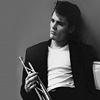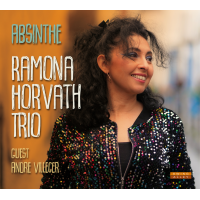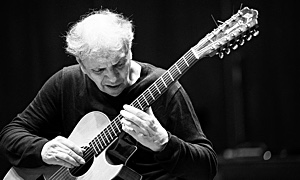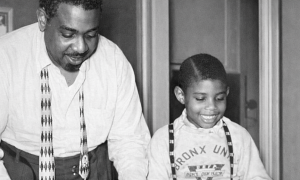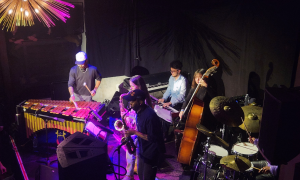Home » Jazz Articles » Profile » 20 Seattle Jazz Musicians You Should Know: Marina Albero
20 Seattle Jazz Musicians You Should Know: Marina Albero

With this series of features, I will introduce you to twenty jazz musicians currently living and working in Seattle. It is not to be seen as any sort of ranking, it has no positional value in that regard. It is simply an effort to introduce the jazz world at large to the vibrance and innovative nature of the jazz scene in and around the jewel city of Seattle, Washington.
4. Marina Albero
A lot can happen in life over six long years. The past six years in the life of Marina Albero have been eventful to the point of being a revelation. She arrived here with her then partner, flamenco jazz pianist Chano Dominguez, and their two children, aged 12 and 15. It was a fresh start, with the hope of finding more work in America than was being afforded them in Europe. The children were to start school in a new country, speaking their third language, behind Catalan and Spanish. Marina would play in the house band at Teatro Zinzanni and tend to the everyday needs of their children, while Chano continued to tour internationally, as he had for a quarter century.While Seattle might seem an unusual landing spot for two musicians from Spain, eschewing New York, Chicago and Los Angeles, it made perfect sense to Albero. Her late father was the legendary Catalan musician, poet and activist Mariano Albero. He brought his family to Seattle when his young daughter Marina was twelve, collaborating on music for the 1992 Summer Olympics in Barcelona with Teatro Zinzanni creator Norman Langill. Langill was and is, Seattle-based. While her father worked, Albero fell in love with the city, and the young piano prodigy was introduced to a musical instrument she could call all her own—the hammered dulcimer, or psalterium. The new instrument allowed her to explore her music outside of the auspices of her family and teachers. Purchased at Dusty Strings in Seattle, Albero has become a major voice in the development of the instrument, pushing it beyond its diatonic boundaries.
Choosing Seattle allowed her to have a comfort zone, and a city she felt offered a sound environment for her children. Five months before the final move in September of 2014, Albero performed in duo with Dominguez at the 2014 Ballard Jazz Festival. opening for saxophonist Sonny Fortune. Dominguez' legend as the artist who introduced piano to flamenco, and in turn, flamenco to jazz, was not quite established on the west coast. The audience did not have a keen sense of what was to come. In Europe and South America, his star was shining brightly. Albero played vibes that evening, with the great Dominguez on piano. The set was dynamic, virtuosic, with a vital, positive energy that completely overwhelmed the audience. Seattle had fallen in love with these two beautiful musicians from Spain.
After the performance, Dominguez told whoever would listen, that Albero was an incredible pianist, this following her stellar performance on vibes. There was a personal warmth and charm about her as well that endeared her quickly to the jazz community. While her background was steeped in classical, flamenco, and the Catalan music of her family, Albero was no stranger to jazz. She found an audience that grew out of the broad-based, open-minded jazz culture in Seattle. The community would then have the good fortune to witness her musical evolution on a new continent. Her music bore the traits of all of the places of her life—her childhood in Barcelona, her teenage years studying classical piano in Cuba, and 20 years of partnership with Dominguez. It would stand to reason that her time in Seattle would impact it as well, and that her musical journey would leave its influence on music, and musicians, in Seattle. The embrace between artist and community was almost instant. While she began to search for musicians to play her music with, musicians recognizing and trusting her talent began to offer her a place on stages across the city.
"I think it's given me a lot of self confidence, Seattle has given me lots of perspective, many chances," says Albero. "The jazz community trusts me on many levels—they let me play swing on vibes, piano. They invited me to play in the Seattle Women's Choir. So it's amazing how many chances they have given me to learn music, onstage. That's given me a lot of self confidence in how music goes through me."
Albero had experienced that kind of trust and embrace in the flamenco community in Spain. Dominguez' roots in the music came with him from his native Cadiz. She had learned much about Afro-Cuban rhythms as well, and had grown up in a household that saw jazz as the classical music of the twentieth century. Her current style as an improviser and composer are heavily influenced by those musical life experiences. Meeting new faces in Seattle, and sharing music with them was a continuation of that sojourn.
"I've learned a lot of specific things here, like tunes or changes, or rhythms, I've met so many new musicians. People like Jacqueline Tabor. It's that kind of character in my life that comes to me, and I feel like they are giving me a PhD for letting me play their music, if that makes sense. It happened before, to me with flamenco musicians. I'm thinking that most of these experiences are with people that don't have a formal education in music. They just have music of their own. So when that happens to me, I always feel like I should study and know more and that's what I do. I talk to people, I practice, but there's something that some people see in me that I feel really lucky about. They see the potential," says Albero
While young Seattle jazz musicians, and young jazzers around the country have historically spent time in New York to find themselves as musicians and gain valuable experience, Albero found a parallel experience by joining her brother in Cuba at the age of fifteen, to study classical piano at the conservatory there, and privately with renowned teacher, Teresita Junco. While it is true that in her three years there, she did not delve into Afro-Cuban music as a pianist, she most certainly found a way to do so otherwise, by dancing with her friends.
"I know Cuban music like I do, because I would go dancing every night no matter what! We would do it at a friend's house with just a few percussion instruments, and singing, in the streets or in the apartment, we didn't need a big orchestra. That's how I learned Cuban music, being with them, hanging out, and especially dancing," she recalls fondly.
Junco's son was a young classical pianist who could improvise. Aldo Lopez Gavilan and Albero became fast friends. They shared their lives and music together for those three years. Their collision in time would impact both musicians greatly. He would move forward over the past twenty years to become a highly regarded composer, film score composer, pianist, and educator, very much reflecting the modern movement of orchestral music in the 21st century. Twenty years after Albero departed Cuba, Lopez Gavilan came to Seattle to perform his music with the Northwest Sinfonietta at Benaroya Hall. The two friends had not seen each other since her departure. Albero's friend had no idea of the musical evolution that his friend had gone through. At this point, she had been performing regularly with her band, and had established herself on the Seattle jazz and improvised music scene. The scene backstage prior to the performance was emotional, with two friends understanding that while much changes over time, much, like love and friendship, stays the same. The two had, and still have, a deep connection. Pre-pandemic, Albero had plans to return to Cuba for the first time since she left, but it was not to be this year.
"I have my best connection there, which is Aldo. He's my brother. We always felt super close. When we met each other after 20 years, it was exactly the same. I had both an amazing inspiration and also a feeling in Cuba that I felt so little all the time, like I am starting from scratch. To me, Cuba was that maximum level experience, but then super welcoming—you didn't feel threatened," she remembers.
It was akin to jazz musicians in America, leaving their hometowns to pursue the music where it is centered internationally in New York, or some smaller, more accessible scene in New Orleans, Seattle or Portland.
"I had that experience to go somewhere and learn so much—for me, it was Cuba," she says.
After the performance at Benaroya, the two friends headed to Vito's, a late night jazz hang on First Hill in Seattle. Kate Olson was there that evening with her band, and welcomed Lopez Gavilan onstage. Both he and Albero would trade off, improvising jazz standards by Monk, and Miles. It was a beautiful experience to see these two musical souls reunited after 20 years, and able play for each other. It seemed so appropriate that they would play for each other, speaking in the common language of jazz music.
Albero was in Seattle only a short time, before she began finding musicians that would best fit into her original music. She was fortunate in meeting multi-reedist Hans Teuber from her Teatro Zinzanni connection, and soon added bassist Evan Flory-Barnes, drummer D’Vonne Lewis and percussionist Jeff Busch. Veteran bassist Jeff Johnson would often join the band, as well as play with Albero as a duo. While all band members were world class jazz musicians, they were as well world class listeners, and assimilated the music quickly. In the end, each musician's contributions would be front and center, as Albero the bandleader was humbled to be in such fast company. The band began performing in the top clubs in town, including the iconic jazz spot, Tula's. Almost a year from the date of her arrival, The Marina Albero Quartet debuted at Tula's to a full house, beginning a run that would gain her many fans and friends in and around Seattle.
She would also perform over time, with Thomas Marriott, Eric Verlinde, Brazilian vocalist Adriana Giordano, and flamenco guitarist Luis Gallo to name but a few. Her star was on the rise in her new home city, and plans for a recording began.
Releasing a triple-CD for a debut album, would not be advised by most in the industry. Somehow, for Albero, it made perfect sense. A Life Soundtrack (Self-Released, 2019) was released in December of 2019, just a short spell from the dawn of the worldwide Covid-19 pandemic. Instead of taking the more predictable route of compressing her diverse musical personality into a 60 minute recording, she breaks down her work into three extended volumes —"Albero," "Agua" and "Music Is Love."
"Albero" is essentially a re-release of a 2010 recording she made in Barcelona with her musical family and friends. There are flamenco influences, featuring guests Dominguez and cantaora Alba Carmona. She shines on psalterium and piano, delving into interpretive Indian and classical forms. "Agua" is a collection of all improvised pieces played "from scratch." She draws on her fertile imagination to create spontaneous passages of melodic improvisation. "Music is Love" is more reflective of her working band here in Seattle, with Teuber, Johnson, Lewis and Busch supplying the firepower for Albero's on-the-edge compositions. The record received a notable review at Jazz Weekly, and a 4 ½ star review at All About Jazz. Albero's career, sidetracked mostly by parenting for nearly two decades, was on the rise. If not for the pandemic, there was a tour planned to ride the wave of reviews and radio play. It was not to be, but certainly in the mix when we can gather again for live music.
In the meantime, she, like most musicians in these times, teaches on Zoom, and with an already extensive background in music education, is developing classes centered on returning music to the family. Considering the marvelous family history she has in music, it would seem a natural fit. While so many students receive instruction with the idea of being a professional, Albero wants to teach families to use music to communicate creatively and emotionally, without fear.
In any case, whether the student is a young child, an adult, an entire family, or a seriously motivated musician, Albero personalizes her methodology at a time when live person-to -person instruction is not possible. Communication and listening are the keys.
"When I talk about music with my students, I ask them about their week, how was playing piano? Some of them don't feel motivated, yet some other weeks, they feel as though they just found this major thing. So I've made a point of checking in with them, always. At the end of the day, you just need somebody listening, and people respond," she says.
What the future holds in this summer and fall of 2020 is an unanswered question for all of us. There is no doubt that our time will come, when we can once again enjoy the fellowship of live music. Albero will continue to engage the musical world as it reveals itself to her. In Seattle, she has found musical growth in so many different directions. She has ingrained herself into the heart and soul of the jazz community here. While she has brought her magic with her to share with musicians, she has also integrated into the jazz life in Seattle. Playing an informal gig at the late night hang, Vito's, Albero, free from being a bandleader and performing her original music, will form a trio and play tunes. In trio with Johnson and Lewis, she is lyrical and bright, romantic and elegant, playing on equal terms with her trio mates. She is a wonderful jazz pianist, something one would perhaps not have been so quick to note six years ago. Her marvelous facility, and fertile, deep musical vocabulary is a tremendous strength to draw from. While life in the Pacific Northwest is yet another blaze on her long and winding journey, it has become home. Music in Seattle, may never be the same.
Photo Credit: Daniel Sheehan
Tags
Profile
Marina Albero
Paul Rauch
Ray Charles
Quincy Jones
Ernestine Anderson
Jelly Roll Morton
Joe Venuti
Larry Coryell
Julian Priester
randy brecker
Chano Dominguez
Jacqueline Tabor
Kate Olson
Evan Flory Barnes
D'Vonne Lewis
Jeff Busch
Jeff Johnson
Thomas Marriott
Eric Verlind
Adriana Giordano
20 Seattle Jazz Musicians You Should Know
PREVIOUS / NEXT
Support All About Jazz
 All About Jazz has been a pillar of jazz since 1995, championing it as an art form and, more importantly, supporting the musicians who make it. Our enduring commitment has made "AAJ" one of the most culturally important websites of its kind, read by hundreds of thousands of fans, musicians and industry figures every month.
All About Jazz has been a pillar of jazz since 1995, championing it as an art form and, more importantly, supporting the musicians who make it. Our enduring commitment has made "AAJ" one of the most culturally important websites of its kind, read by hundreds of thousands of fans, musicians and industry figures every month.



